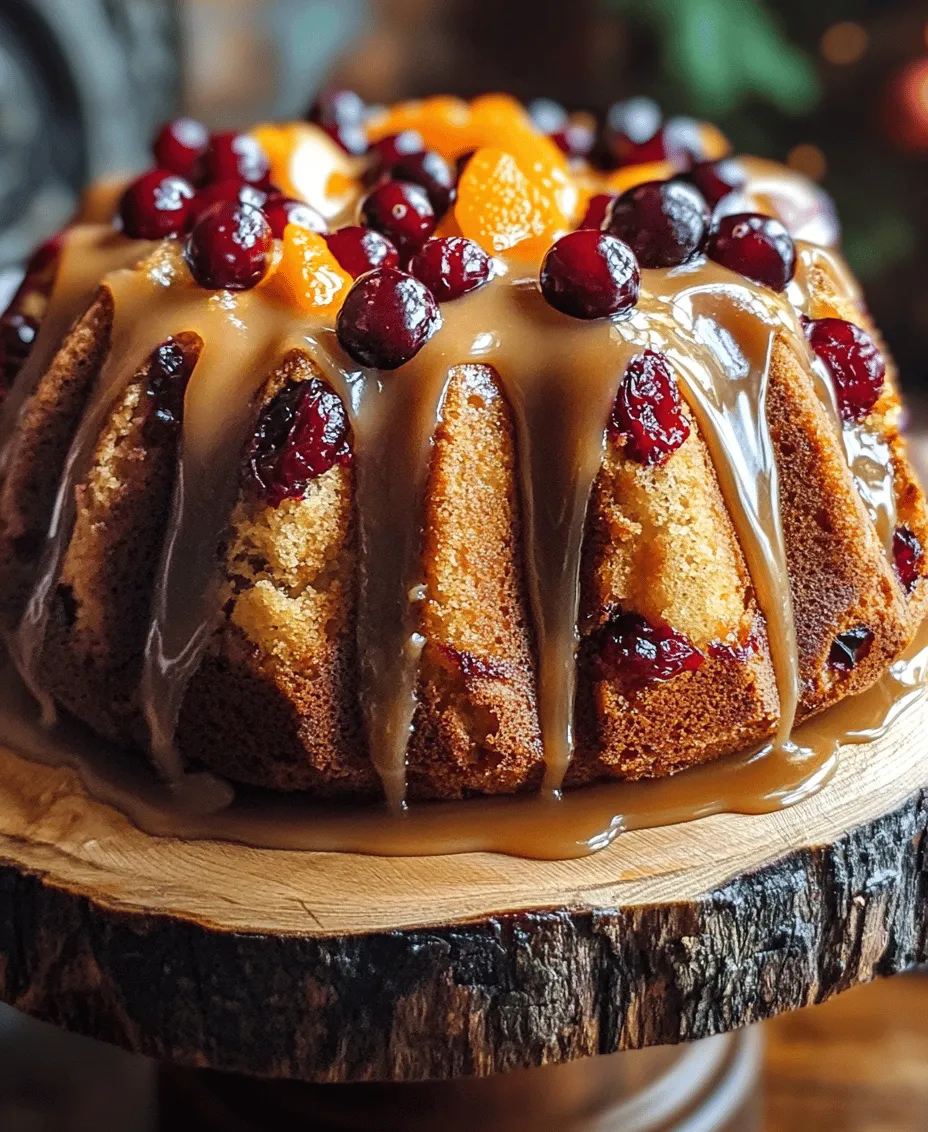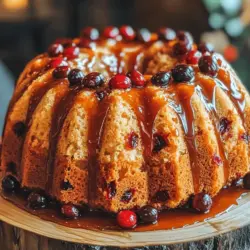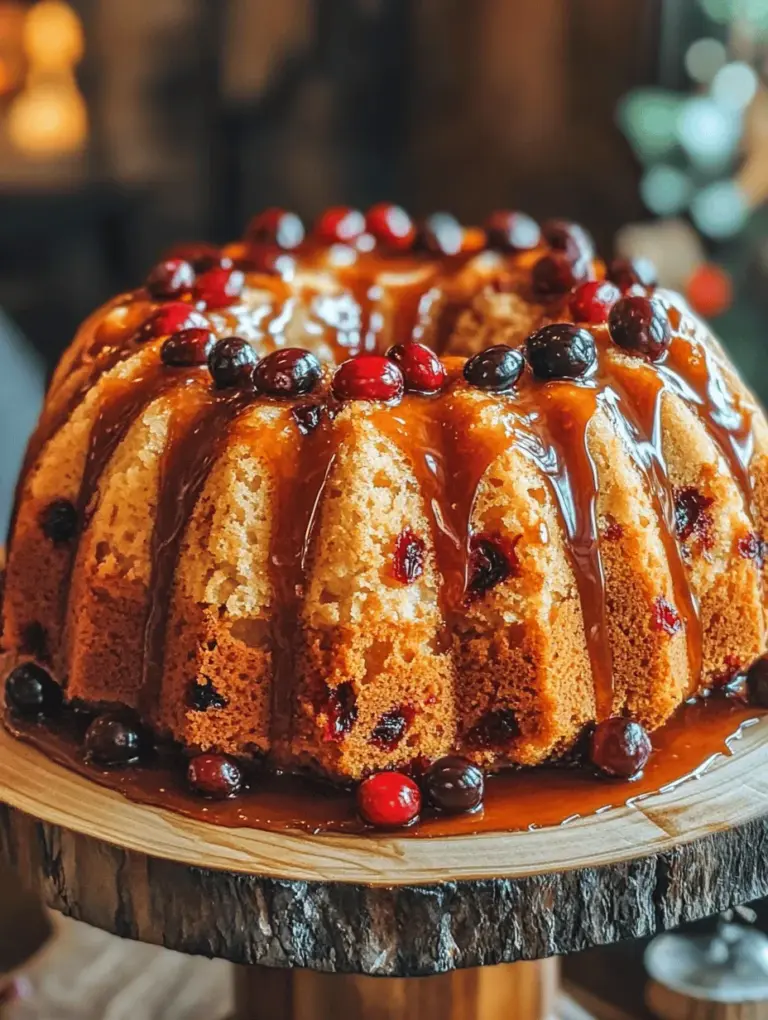Introduction
As the festive season approaches, the desire for delightful, flavorful desserts often takes center stage in our culinary adventures. One cake that perfectly encapsulates the spirit of the holidays—or any special occasion, for that matter—is the Cranberry Orange Bliss Bundt Cake. This beautiful cake intertwines the tartness of fresh cranberries with the bright, zesty notes of orange, resulting in a captivating flavor profile that is both refreshing and comforting.
Imagine a moist cake, each slice bursting with the tangy sweetness of cranberries and the invigorating aroma of fresh oranges. Topped with a luscious orange glaze that adds an extra layer of sweetness, this Bundt cake is not only visually stunning but also incredibly satisfying. Whether you’re celebrating a holiday gathering, a birthday, or simply indulging in a well-deserved treat, this cake is sure to become a beloved addition to your baking repertoire.
In this article, we will delve into the essential ingredients that craft this delectable dessert, provide you with step-by-step baking instructions, and share some tips and tricks to ensure your Cranberry Orange Bliss Bundt Cake turns out perfectly every time. So, preheat your oven and prepare to create a dessert that will leave your guests asking for seconds, or even thirds!
Understanding the Ingredients
Every incredible cake begins with high-quality ingredients, and the Cranberry Orange Bliss Bundt Cake is no exception. Each element in this recipe plays a vital role in achieving the perfect balance of flavor, texture, and moisture. Let’s break down the essential ingredients that contribute to the unique profile of this cake.
All-Purpose Flour
All-purpose flour serves as the foundation of the cake, providing the necessary structure and texture. When sifted, it helps to aerate the flour, resulting in a lighter cake. The gluten in the flour develops as you mix the batter, which gives the cake its structure while still allowing it to remain tender and moist. For this recipe, using a reliable all-purpose flour will ensure that your cake rises beautifully and has the perfect crumb.
Sugars: Granulated vs. Brown
The choice of sugar can significantly affect the flavor and moisture of your cake. Granulated sugar is the primary sweetener in this recipe, contributing to the overall sweetness and helping to caramelize the cake during baking. On the other hand, brown sugar adds a richer, more complex flavor due to its molasses content. It also helps retain moisture, resulting in a denser and more flavorful cake. Combining both sugars in the right proportions can elevate your Cranberry Orange Bliss Bundt Cake to a whole new level.
Butter and Eggs
Using unsalted butter is crucial for this recipe, as it allows you to control the sodium content of the cake. Butter not only adds richness and flavor but also creates a tender crumb when creamed with sugar. Large eggs are equally important, as they provide moisture and help with the cake’s structure. The proteins in the eggs contribute to the cake’s rise, while the fat enhances its texture. Be sure to bring both the butter and eggs to room temperature before mixing to ensure a smooth, well-emulsified batter.
Cranberries: Fresh vs. Frozen
When it comes to cranberries, you may wonder whether to use fresh or frozen. Fresh cranberries are typically available during the fall and winter months, providing a bright, tart flavor that pairs beautifully with the orange. However, if you can’t find fresh cranberries, frozen cranberries can be a great alternative. They are harvested at peak ripeness and flash-frozen, preserving their flavor and nutrients. Just be sure to rinse and drain them well before adding them to the batter to avoid excess moisture.
Orange Zest and Juice
The incorporation of fresh orange zest and juice is what truly elevates this Bundt cake. The zest contains essential oils that provide a concentrated citrus flavor, while the juice adds moisture and a pleasant tartness. Using fresh oranges ensures that you capture the vibrant flavor that dried or bottled alternatives simply cannot match. When zesting, make sure to only remove the outer layer of the peel, as the white pith beneath can be bitter.
Baking Powder and Baking Soda
These two leavening agents work together to create the perfect rise in your Bundt cake. Baking powder contains both an acid and a base, allowing it to create carbon dioxide bubbles when combined with moisture and heat. This helps the cake rise and become fluffy. Baking soda, on the other hand, requires an acidic ingredient (in this case, the orange juice) to activate it. The combination of these two agents will ensure that your cake is light and airy, avoiding any dense or heavy texture.
Cinnamon: A Flavor Enhancer
Last but not least, ground cinnamon adds a hint of warmth and depth to the overall flavor profile of the cake. Its sweet-spicy notes harmonize beautifully with the tartness of the cranberries and the brightness of the orange. A touch of cinnamon can transform your Cranberry Orange Bliss Bundt Cake into a truly comforting dessert, reminiscent of cozy family gatherings and holiday celebrations.
Preparing for Success: Baking Essentials
To ensure a seamless baking experience and achieve the best results, it is essential to prepare adequately. Here are the necessary tools and preparations for baking the Cranberry Orange Bliss Bundt Cake.
Choosing the Right Bundt Pan
Selecting the right Bundt pan is crucial for achieving an evenly baked cake that releases easily. Opt for a high-quality non-stick Bundt pan, preferably with a detailed design, as it will help create beautiful patterns on the cake’s surface. If you’re using a metal pan, consider greasing it well with butter or shortening and dusting it with flour to prevent sticking. Silicone Bundt pans are also an excellent choice, as they allow for easy removal without the need for additional greasing.
Prepping the Oven
Preheating the oven is a fundamental step that should never be overlooked. By preheating your oven to the specified temperature before placing the cake inside, you ensure that the cake begins to rise and bake evenly right from the start. This helps prevent uneven baking, which can lead to a dry or dense cake. For the Cranberry Orange Bliss Bundt Cake, a temperature of 350°F (175°C) is ideal.
Greasing and Flourishing the Bundt Pan
To avoid any potential sticking, it’s crucial to properly prepare your Bundt pan before adding the batter. Start by generously greasing the pan with unsalted butter or cooking spray, making sure to cover all the nooks and crannies of the design. After greasing, dust the inside of the pan with flour, tapping out any excess. This simple step will create a barrier between the cake and the pan, allowing for a clean release once it’s baked. For added assurance, consider lining the bottom of the pan with a circle of parchment paper.
With these preparations in place, you are well on your way to creating a stunning Cranberry Orange Bliss Bundt Cake that is sure to impress. In the next section, we will dive into the detailed baking instructions, guiding you through each step to ensure your cake turns out perfectly every time. Stay tuned for a delightful culinary journey!

Preparing the Bundt Pan
Before diving into the baking process, it’s crucial to prepare the Bundt pan properly to ensure your cake releases effortlessly after baking. Start by selecting a high-quality non-stick Bundt pan, which will help prevent sticking. Follow these steps for optimal results:
1. Grease the Pan: Use a pastry brush or a paper towel to apply a generous layer of softened butter or cooking spray to the entire interior of the pan, ensuring every crevice is coated. This step is essential as Bundt cakes often have intricate designs that can trap the batter.
2. Flour the Pan: After greasing, sprinkle a tablespoon or two of all-purpose flour into the pan. Rotate the pan to coat all greased surfaces with flour, tapping out any excess. This creates a barrier between the cake and the pan, further reducing the chances of sticking.
3. Chill the Pan (Optional): For added insurance against sticking, place the greased and floured pan in the refrigerator for about 15 minutes before adding the batter. This helps the fat solidify and can create a smoother release.
Step-by-Step Guide to Baking the Cake
Mixing Dry Ingredients
Start your baking adventure by mixing the dry ingredients. In a medium bowl, combine 2 cups of all-purpose flour, 1 teaspoon of baking powder, 1/2 teaspoon of baking soda, 1/2 teaspoon of salt, and 1 teaspoon of ground cinnamon.
1. Whisk Together: Use a whisk to blend these ingredients thoroughly. This process aerates the flour and evenly distributes the leavening agents and spices, which is crucial for a uniform rise. Set this mixture aside as you move on to the next step.
Creaming Butter and Sugars
In a large mixing bowl, add 1 cup of softened unsalted butter and 1 cup of granulated sugar, along with 1/2 cup of packed brown sugar.
1. Creaming Technique: Using an electric mixer, beat the butter and sugars together on medium speed for about 3-5 minutes. The mixture should become light and fluffy, indicating that air has been incorporated, which will help your cake rise beautifully.
2. Ideal Consistency: The mixture should be pale in color and have a smooth, creamy texture. This process is vital because it sets the foundation for the cake’s moistness and overall structure.
Incorporating Eggs and Flavorings
Next, add 3 large eggs to the creamed mixture, one at a time.
1. Adding Eggs: Beat well after each addition to ensure that the eggs are fully incorporated. This step helps to emulsify the mixture, creating a stable batter.
2. Flavor Enhancements: Incorporate 1 teaspoon of pure vanilla extract and the zest of one large orange. The zest adds a vibrant citrus flavor that complements the cranberries beautifully.
Combining Wet and Dry Ingredients
Now it’s time to bring the wet and dry ingredients together.
1. Mixing Method: Add half of the dry ingredient mixture to the creamed butter mixture, followed by 1/2 cup of buttermilk. Mix on low speed until just combined. Then add the remaining dry ingredients.
2. Avoid Overmixing: It’s important to mix just until the flour is incorporated. Overworking the batter can lead to a tough cake, so stop mixing as soon as you no longer see dry flour.
Folding in Cranberries
Prepare 1 1/2 cups of fresh or frozen cranberries (if using frozen, do not thaw them).
1. Gentle Folding: Gently fold the cranberries into the batter using a spatula. This technique ensures that the berries are evenly distributed without breaking them, preventing a mushy texture in your cake.
Baking the Cake
Pour the batter into the prepared Bundt pan, smoothing the top with a spatula.
1. Baking Time: Preheat your oven to 350°F (175°C) and bake the cake for about 50-60 minutes.
2. Testing for Doneness: To check if the cake is done, insert a toothpick into the center. If it comes out clean or with a few moist crumbs, the cake is ready. If it has wet batter clinging to it, return the cake to the oven for an additional 5-10 minutes.
Cooling and Glazing the Cake
Once baked, remove the cake from the oven and let it cool in the pan for about 10-15 minutes.
1. Cooling Process: Carefully invert the cake onto a wire rack to cool completely. This step is crucial for preventing sogginess.
2. Preparing the Glaze: While the cake cools, prepare the glaze. In a small bowl, whisk together 1 cup of powdered sugar with 2-3 tablespoons of fresh orange juice until smooth.
Crafting the Perfect Glaze
Achieving the right consistency for the glaze is essential for a beautiful finish.
1. Consistency Check: The glaze should be thick but pourable. If it’s too thin, add more powdered sugar; if too thick, add a splash more orange juice.
2. Enhancing Flavor: For extra flavor, consider adding a pinch of salt or a drop of vanilla extract to the glaze.
Drizzling the Glaze
1. Even Distribution: Once the cake has completely cooled, drizzle the glaze over the top of the cake. You can use a spoon or a piping bag for more control. Allow the glaze to drip down the sides for a visually appealing presentation.
2. Setting the Glaze: Let the glaze set for about 15 minutes before slicing the cake. This allows it to firm up slightly, preventing it from running off the cake when served.
Serving and Storing the Cake
The Cranberry Orange Bliss Bundt Cake is versatile in its serving options.
1. Serving Suggestions: This cake can be served as a delightful dessert following dinner, as a sweet breakfast treat, or an afternoon snack. Pair it with whipped cream, cream cheese frosting, or a scoop of vanilla ice cream for an indulgent experience.
2. Storage Tips: Store leftover cake in an airtight container at room temperature for up to three days or in the refrigerator for up to a week. If you want to keep it longer, consider freezing individual slices wrapped tightly in plastic wrap, which can last for up to three months.
Ideal Pairings with the Cake
To enhance the enjoyment of your Cranberry Orange Bliss Bundt Cake, consider the following pairings:
1. Beverages: A cup of hot tea, a glass of sparkling cider, or a rich coffee can complement the cake’s flavors beautifully.
2. Desserts: Serve alongside a scoop of vanilla bean ice cream or a dollop of crème fraîche to balance the tartness of the cranberries.
Conclusion
The Cranberry Orange Bliss Bundt Cake is more than just a dessert; it’s a celebration of flavors that brings joy to any occasion. With its perfect balance of tart and sweet, moist texture, and stunning presentation, this cake is sure to impress family and friends alike. Whether enjoyed with a cup of tea or as a centerpiece at your holiday gathering, this Bundt cake embodies the spirit of togetherness and celebration. Embrace the joy of baking and savor every delightful slice of this exquisite cake.

